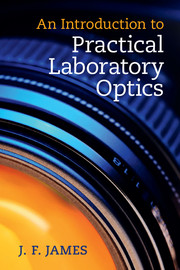Book contents
- Frontmatter
- Contents
- Preface
- 1 Introduction: centred optical systems
- 2 Telescopes and binoculars
- 3 Eyepieces, eyes and colour
- 4 Cameras and camera lenses
- 5 The scientific CCD camera
- 6 Spectrometry
- 7 Interferometers and their uses
- 8 Electro-optical effects and their practical uses
- 9 Microscopes and projectors
- 10 Siderostats and coelostats
- 11 The detection and measurement of radiation
- 12 Practicalities
- Appendix A Gaussian optics
- Appendix B Optical aberrations
- Appendix C A brief introduction to Fourier optics
- Further reading
- Index
- Frontmatter
- Contents
- Preface
- 1 Introduction: centred optical systems
- 2 Telescopes and binoculars
- 3 Eyepieces, eyes and colour
- 4 Cameras and camera lenses
- 5 The scientific CCD camera
- 6 Spectrometry
- 7 Interferometers and their uses
- 8 Electro-optical effects and their practical uses
- 9 Microscopes and projectors
- 10 Siderostats and coelostats
- 11 The detection and measurement of radiation
- 12 Practicalities
- Appendix A Gaussian optics
- Appendix B Optical aberrations
- Appendix C A brief introduction to Fourier optics
- Further reading
- Index
Summary
Cleaning optical surfaces
You can clean a seriously stained or corroded surface by gentle polishing with a fine wet rag and a dab of rouge or cerirouge. This is a last resort of course, on a surface which would otherwise be discarded. Apart from this you should never, never touch a dirty optical surface with any solid other than a fine sable-hair artist's brush dipped in a suitable solvent such as analytical quality iso-propyl alcohol. The sweat on your fingers (which helps in fingerprinting) is acid enough to etch glass. There is never any reason to allow a cloth to touch an optical-quality glass surface, as it will almost certainly have abrasive silica particles embedded in it.
Camera lenses
Camera lenses are best kept with a permanent anti-ultra-violet filter in place. If it is necessary to clear dust, a blower-brush is the proper device. If the glass surface has stains or dried water-spots, then the solvent of choice is iso-propyl alcohol. Diethyl ether can also be used in a well-ventilated place and ethyl alcohol too, although it is not such a good solvent for lipids. Diethyl ether evaporates quickly and the consequent cooling of the surface may cause water-drop condensation in high humidity surroundings. Ethyl alcohol will dissolve water.
The basic rule is: don't touch and don't polish with a cloth.[…]
Information
- Type
- Chapter
- Information
- An Introduction to Practical Laboratory Optics , pp. 141 - 148Publisher: Cambridge University PressPrint publication year: 2014
